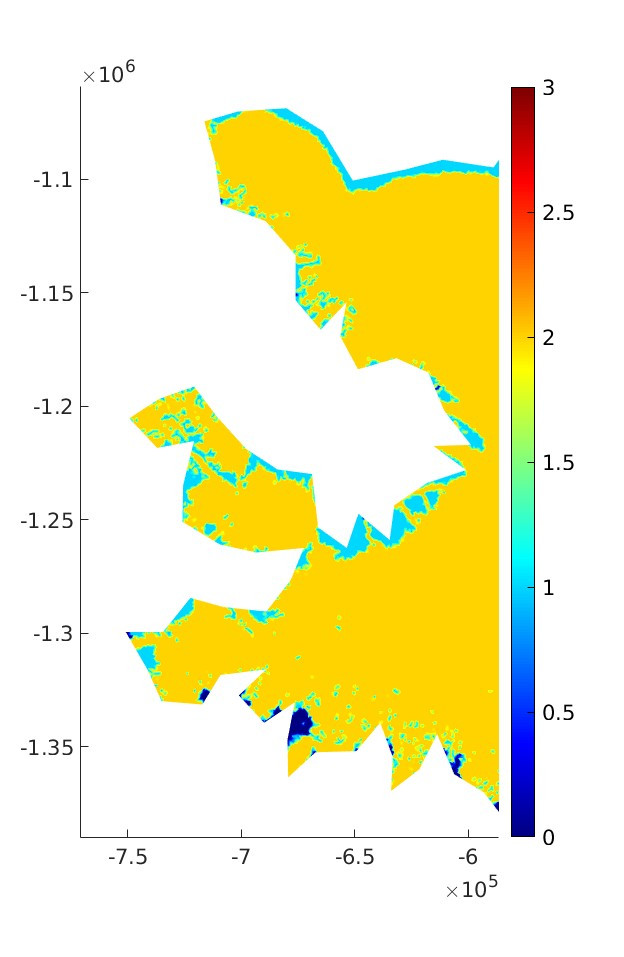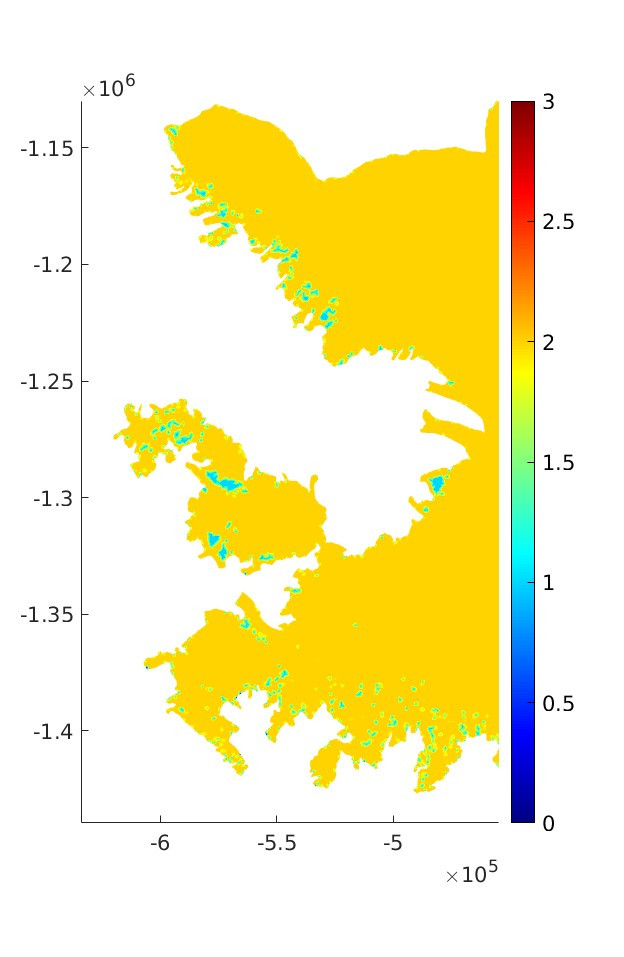Hi,
I've got some general, potentially ignorant questions about the general ISSM model setup workflow:
1. outline data: For initializing a model, ISSM always requires an ARGUS outline file. I was wondering if there are reference outline that the ice sheet modelling community has agreed on? Or does everyone create their own outline? For Greenland, I've been using the ISSM tutorial outline, but it seems awfully coarse compared to the BedMachine map (see below, 0 = ocean, 1 = ice-free land, 2 = grounded ice). I've created my own outline file (see below) which is finer, but it was an incredibly tedious process*. Then again, a coarse outline might not be an issue compared to the overall size of the ice?
2. basal melt: For the ice thickness equations (https://issm.jpl.nasa.gov/documentation/masstransport/) I know that the surface mass balance is an input, but what about the basal melt? If I understand correctly, a big reason for computing the pressure is that the ice melt temperature is pressure dependent, and [Greve, Blatter: dynamics of ice sheets and glaciers (2009), p. 82] gives a formula for how to compute the basal melt rate. Is that how ISSM does it? I would have assumed it except that md.basalforcings.groundedice_melting_rate is an input, so I want to make sure.
3. sensitivity of the basal friction: I've been thinking about the inversion process for the basal friction. First, is there a common way for choosing the weights? I followed a couple of references that all referenced back to https://www.cambridge.org/core/journals/journal-of-glaciology/article/dependence-of-centuryscale-projections-of-the-greenland-ice-sheet-on-its-thermal-regime/71233B1A12B0348B4AB38D9B2EE493AC where they are introduced as "non-dimensionalizing constants" with very little regularization (1e-7).
I'm also curious about in which directions the basal friction field is the most uncertain. Typically I'd look at the strongest modes of the Hessian for that, potentially approximated as in the Gauss-Newton method. ISSM's default minimization is Brent's method, which only computes the gradient. I've seen though that ISSM has an interface to TAO, and at least https://agupubs.onlinelibrary.wiley.com/doi/pdfdirect/10.1002/jgrf.20125 used the Newton method in their inversion, so I assume somewhere in ISSM the Hessian action (or an approximate) gets computed. Is there a way for accessing it as a function from the MATLAB interface?
Thanks a lot!
Nicole
*I might be making a fool of myself by specifying, but this is what I did to get an outline for Greenland: I used the answer here https://issm.ess.uci.edu/forum/d/284-create-mesh-with-bamg-without-augus-file to create outlines for all the grounded ice. Then chose the one for main Greenland (341,315 vertices), discarding all others. I coarsened the outline with expcoarsen to 150m (BedMachine resolution) (240,952 vertices remaining), manually trimmed the outline with exptools to not contain strong bottlenecks (183,550 vertices remaining), created a new mask from that, blurred it, made a new outline, coarsened it to 750 m to remove duplicate vertices (28,788 vertices remaining), and then went over it again manually to remove sharp triangles and reposition vertices when the blurring had included areas that were previously outside the mask (25,470 vertices remaining). I'd rather not repeat this process for other ice sheets.

